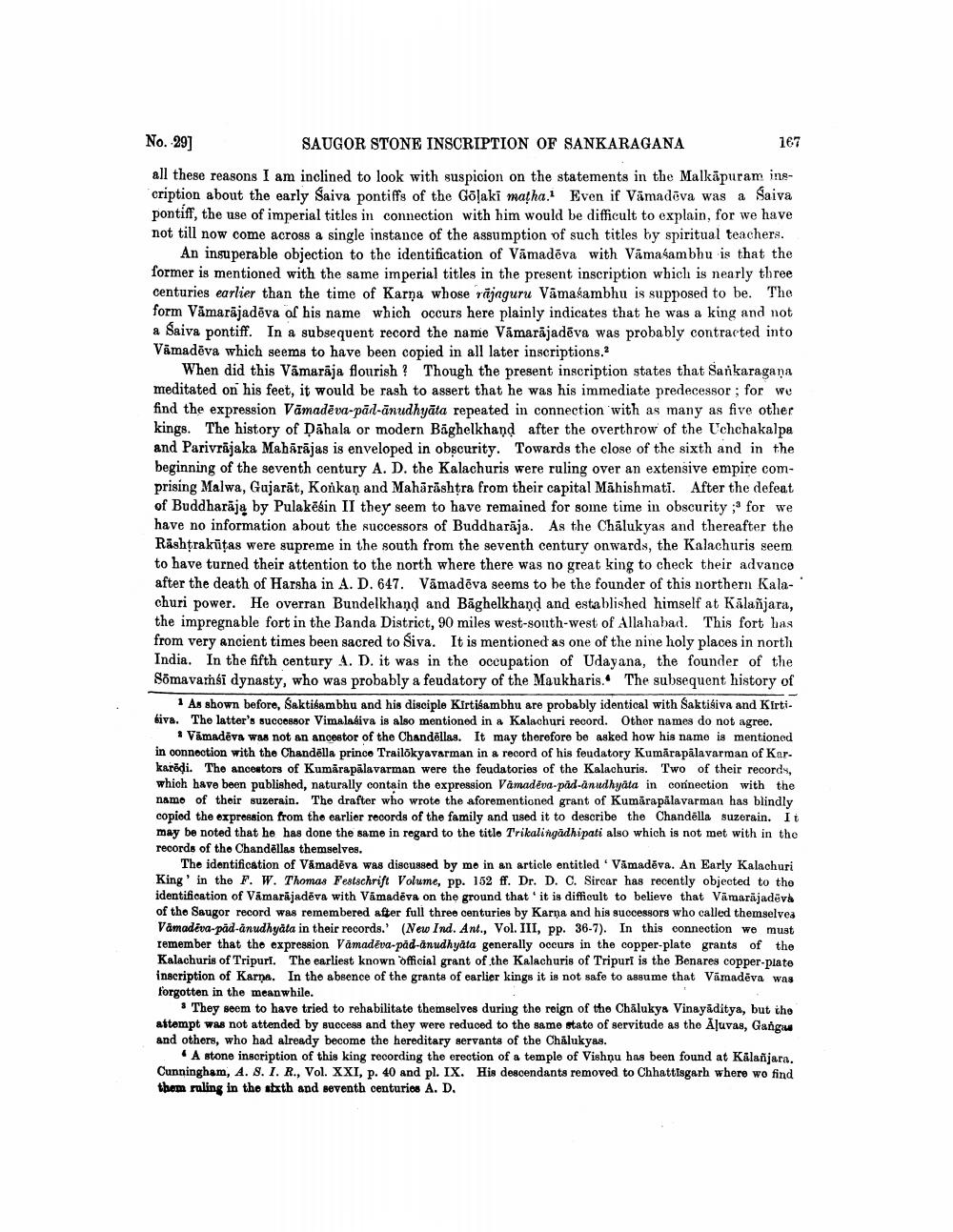________________
No. 29]
SAUGOR STONE INSCRIPTION OF SANKARAGANA
167
all these reasons I am inclined to look with suspicion on the statements in the Malkāpuram inscription about the early Saiva pontiffs of the Golaki matha. Even if Vāmadova was a Saiva pontiff, the use of imperial titles in connection with him would be difficult to explain, for we have not till now come across a single instance of the assumption of such titles by spiritual teachers.
An insuperable objection to the identification of Vāmadēva with Vāmasambhu is that the former is mentioned with the same imperial titles in the present inscription which is nearly three centuries earlier than the time of Karna whose rājaguru Vāmasambhu is supposed to be. The form Vămarājadēva of his name which occurs here plainly indicates that he was a king and not a Saiva pontiff. In a subsequent record the name Vámarājadēva was probably contracted into Vāmadova which seems to have been copied in all later inscriptions.?
When did this Vämarāja flourish? Though the present inscription states that Sankaragana meditated on his feet, it would be rash to assert that he was his immediate predecessor ; for we find the expression Vāmadēva-pād-ānudhyāta repeated in connection with as many as five other kings. The history of Dāhala or modern Bäghelkhand after the overthrow of the Uchchakalpa and Parivrājaka Mahārājas is enveloped in obscurity. Towards the close of the sixth and in the beginning of the seventh century A. D. the Kalachuris were ruling over an extensive empire comprising Malwa, Gujarat, Konkan and Mahārāshtra from their capital Māhishmati. After the defeat of Buddharāja by Pulakēsin II they seem to have remained for some time in obscurity ;' for we have no information about the successors of Buddharāja. As the Chalukyas and thereafter the Rashtrakūtas were supreme in the south from the seventh century onwards, the Kalachuris seem to have turned their attention to the north where there was no great king to check their advance after the death of Harsha in A. D. 647. Vāmadēva seems to be the founder of this northern Kalachuri power. He overran Bundelkhand and Bāghelkhand and established himself at Kālañjara, the impregnable fort in the Banda District, 90 miles west-south-west of Allahabad. This fort bas from very ancient times been sacred to Siva. It is mentioned as one of the nine holy places in north India. In the fifth century A. D. it was in the occupation of Udayana, the founder of the Sõmavamsi dynasty, who was probably a feudatory of the Maukharis. The subsequent history of
As shown before, Saktibambhu and his disciple Kirtisambhu are probably identical with Saktisiva and Kirti. siva. The latter's successor Vimalasiva is also mentioned in a Kalachuri record. Other names do not agree.
* Vāmadēva was not an ancestor of the Chandēllas. It may therefore be asked how his name is mentioned in connection with the Chandēlla prince Trailökyavarman in a record of his feudatory Kumārapālavarman of Karkarēdi. The ancestors of Kumāra pālavarman were the feudatories of the Kalachuris. Two of their records, which have been published, naturally contain the expression Vamadēva-pád-anudhyata in connection with the namo of their suzerain. The drafter who wrote the aforementioned grant of Kumārapālavarman has blindly copied the expression from the earlier records of the family and used it to describe the Chandella suzerain. It may be noted that he has done the same in regard to the titlo Trikalingadhipati also which is not met with in the records of the Chandēllas themselves.
The identification of Vámadēva was discussed by me in an article entitled 'Vămadēva. An Early Kalachuri King' in the F. W. Thomas Festschrift Volume, pp. 152 ff. Dr. D. C. Sircar has recently objected to the identification of Vamarājadeva with Vámadēva on the ground that it is difficult to believe that Vâmarajadeva of the Saugor record was remembered after full three centuries by Karna and his successors who called themselves Vamadeva-pad-anudhyata in their records.' (New Ind. Ant., Vol. III, pp. 36-7). In this connection we must remember that the expression Vāmadēva-pad-anudhyāta generally occurs in the copper-plate grants of the Kalachuris of Tripurl. The earliest known official grant of the Kalachuris of Tripurl is the Benares copper-plate inscription of Karna. In the absence of the grants of earlier kings it is not safe to assume that Vāmadēva was forgotten in the meanwhile.
3 They seem to have tried to rehabilitate themselves during the reign of the Chalukya Vinayaditya, but the attempt was not attended by success and they were reduced to the same state of servitude as the Āļuvas, Gangaw and others, who had already become the hereditary servants of the Chalukyas.
A stone inscription of this king recording the erection of a temple of Vishņu has been found at Kälañjara. Cunningham, A. 8. I. R., Vol. XXI, p. 40 and pl. IX. His descendants removed to Chhattisgarh where wo find thom ruling in the stxth and seventh centuries A. D.




